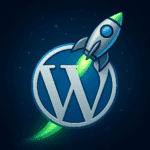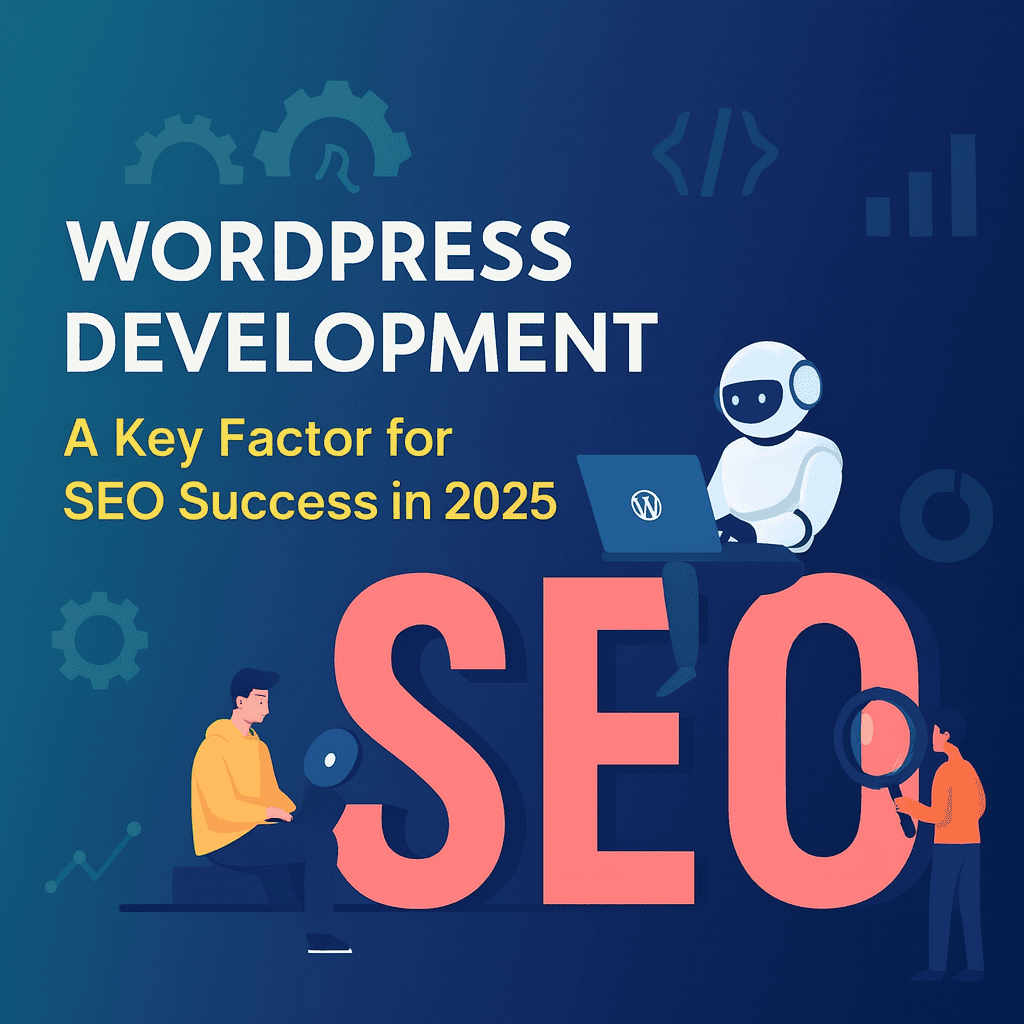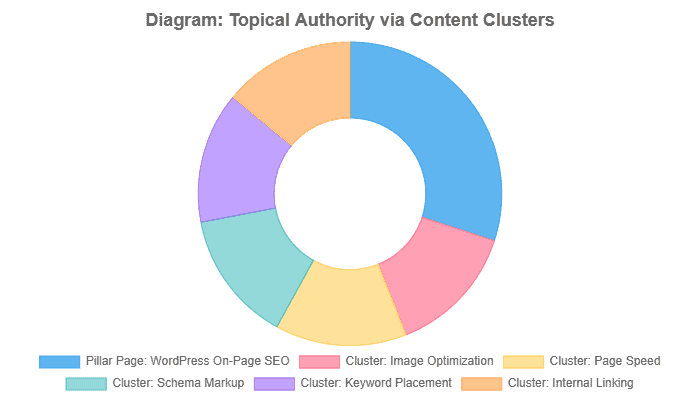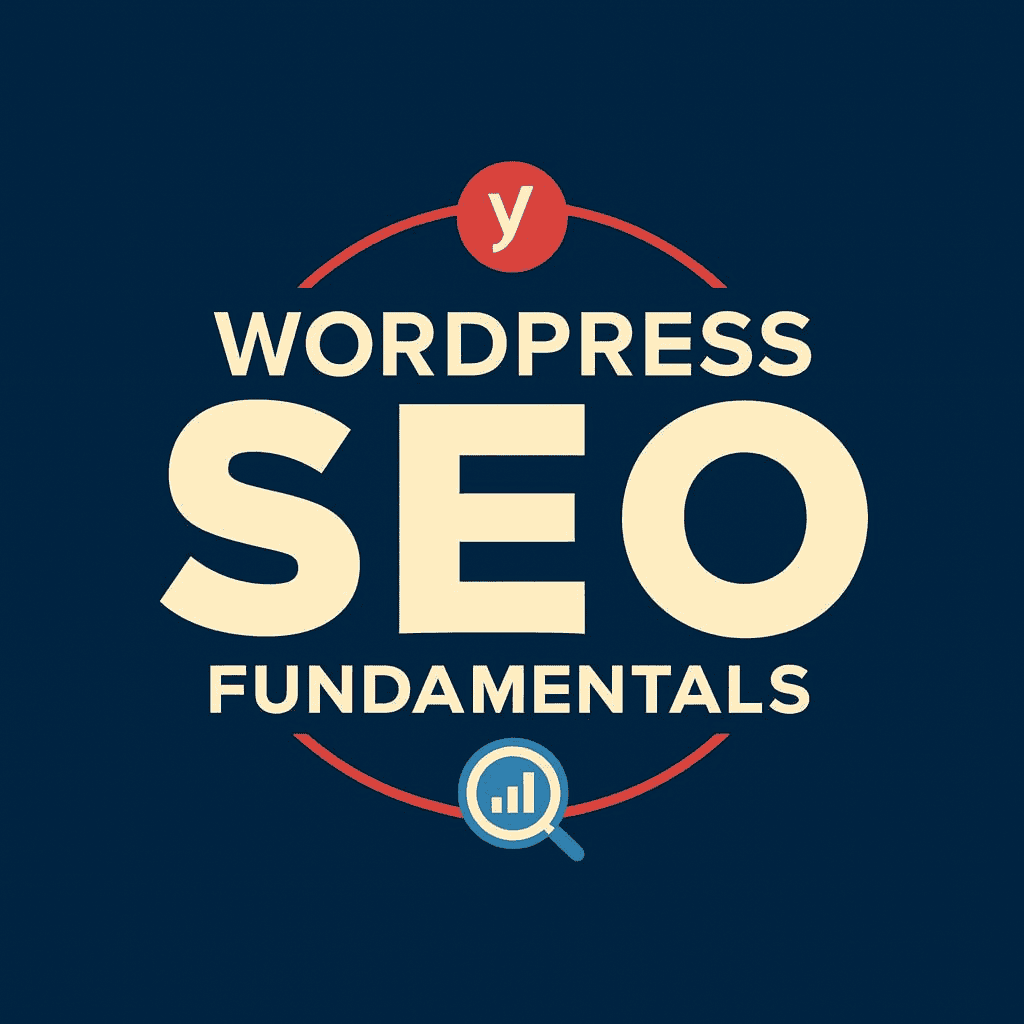The Ultimate Guide to WordPress On-Page SEO in 2025
TL;DR: WordPress On-Page SEO optimizes individual web pages to boost search rankings and user engagement by refining content, titles, meta descriptions, and technical elements using WordPress tools or plugins. In 2025, it aligns with Google’s E-E-A-T and Core Web Vitals, offering benefits like higher rankings, increased click-through rates, targeted traffic, and improved conversions. Key practices include keyword optimization, schema markup, and mobile-friendly design, ensuring a strong ROI for businesses.
Table of Contents
Introduction
The Bedrock: WordPress Technical SEO Fundamentals
Crafting a Semantically Sound HTML Structure
Mastering Meta Tags for Maximum Click-Through Rate (CTR)
Winning Rich Snippets with Schema Markup
The Engine: Advanced Content Optimization Strategies
The Keyword Placement & Topical Authority Blueprint
Optimizing for “People Also Ask” (PAA) and AI Overviews
The Chassis: WordPress-Specific On-Page Tuning
Perfecting Permalinks for Clarity and SEO
High-Impact Image Optimization Workflow
Achieving Blazing-Fast Page Speed (Core Web Vitals)
Your Action Plan: The WordPress On-Page SEO Audit & Final Checklist
The Ultimate WordPress On-Page SEO Checklist (TL;DR)
WordPress On Page SEO FAQ
Final Thoughts
Appendices
Appendix A: The Complete WordPress Technical SEO Audit Checklist
Appendix B: Complete Article & FAQ Schema Markup (JSON-LD)
What Is WordPress On Page SEO?
WordPress On-Page SEO involves optimizing individual web pages on a WordPress site to improve their search engine rankings and attract relevant traffic by refining content, structure, and technical elements like titles, meta descriptions, headings, and images directly within the platform’s editor or with SEO plugins. This targeted approach ensures each page aligns with user intent and Google’s ranking factors, such as E-E-A-T and Core Web Vitals, to maximize visibility in 2025’s AI-driven search landscape. The benefits of WordPress On-Page SEO include:
- Enhancing search rankings through optimized titles, meta tags, and keyword placement.
- Increasing click-through rates with compelling meta descriptions and schema markup for rich snippets.
- Improving user experience with clear heading structures and fast-loading, mobile-friendly pages.
- Driving targeted traffic by aligning content with specific user search intents.
- Boosting conversions by optimizing calls-to-action and internal linking.
- Strengthening site authority with consistent, high-quality content that builds trust with search engines and users.
The Guide For WordPress On-Page SEO
In 2025, the search landscape is more competitive than ever. With Google’s AI Overviews reshaping SERPs and user-centric signals becoming paramount, mastering the elements you can control is no longer optional—it’s essential. The old playbook of simply “doing SEO” is obsolete. Billions of people still use the internet to search for answers, but they do so in new places and in new ways. As noted by WordStream, what died is the 2015 version of SEO; it’s no longer just about climbing a list of blue links. This guide offers a comprehensive, step-by-step framework for optimizing WordPress on-page SEO. We will dissect the technical, content, and platform-specific strategies required not just to compete, but to dominate the rankings. This is not a general overview; it is a deep dive into the actionable tactics that deliver measurable results, focusing exclusively on the on-page and technical aspects within the WordPress ecosystem.
The Bedrock: WordPress Technical SEO Fundamentals
Before a single word of content is optimized, your site’s technical foundation must be flawless. This is the realm of WordPress technical SEO, where you ensure that search engines and Large Language Models (LLMs) can efficiently crawl, interpret, and trust your website. Technical SEO involves optimizing the backend of your website to make it easier for search engines to crawl, index, and understand your content. Getting this right is the prerequisite for everything that follows. A comprehensive seo audit is the first step to identifying and rectifying these foundational issues.
Crafting a Semantically Sound HTML Structure
Objective: To provide a clear, logical hierarchy that search engines can understand, which is crucial for both traditional rankings and inclusion in AI-generated answers. A theme will impact how the website displays many core content elements essential to SEO, including headings, text, and images. Crawlers more easily understand a well-structured site with semantic HTML.
Core Principles:
Heading Hierarchy (H1-H6): Proper heading use is a fundamental signal of content structure. Headings are the backbone of your content, describing the content on a webpage and making the site easier for both users and search engines to scan.
- The H1 Tag: Emphasize the “one H1 per page” rule. This tag should represent the primary focus of the page and effectively summarize its content. It should contain your primary target keyword. For example, a page about this topic would have an H1 like
<h1>A Guide to WordPress On-Page SEO</h1>. This is a critical element that search engines use to understand the primary topic of your page. - H2 & H3 Tags: Use H2 tags for the main sections of your content and H3s for sub-points within those sections. This creates a logical outline that is easy for both users and search engines to follow. This structure helps organize content into logical chunks, a best practice recommended by experts. Yoast SEO suggests placing a heading above every long paragraph or group of paragraphs that form a thematic unit, with the text following a subheading ideally being between 250-350 words.
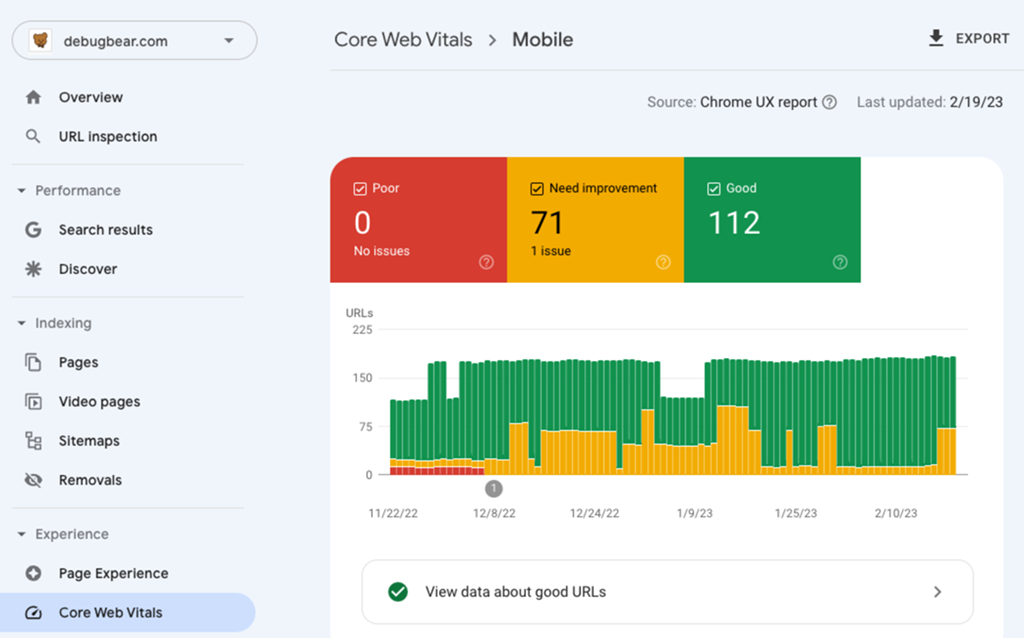
A Google PageSpeed Insights report showing Core Web Vitals metrics for mobile devices, a key part of a WordPress technical seo auditSemantic HTML5 Elements: Modern, high-quality themes (e.g., Astra, GeneratePress, Kadence) use semantic tags like <article>, <section>, <nav>, and <main> correctly. These elements clearly convey their meaning to both the browser and the developer. This helps crawlers differentiate between main content, sidebars, and footers, avoiding “div soup,” which can confuse crawlers and negatively impact machine readability. A theme with clean code is a cornerstone of good on-page performance.
“It’s easy to consider website themes as just a splash of color on top of a finished structure. But there’s so much more involved.” – John Mueller, Google
How to Check: Advise users to right-click on their page, select “Inspect,” and look for these tags wrapping their main content areas. A well-structured theme will be used <main> for the primary content block and <article> for individual posts or articles, which is a best practice for accessibility and machine readability.
Mastering Meta Tags for Maximum Click-Through Rate (CTR)
Objective: To craft compelling SERP snippets that entice users to click on your result over competitors. While Google’s John Mueller has stated that meta tags are used to form SERP snippets and not directly for rankings, a sound snippet makes people visit your page, which is the ultimate goal .
Implementation: The easiest way to manage meta tags is with a dedicated plugin. This approach simplifies the process and ensures you adhere to best practices without requiring direct code editing.
- Recommended Plugins: All-in-One SEO (AIOSEO), Rank Math, or Yoast SEO are the top contenders. They provide intuitive interfaces within the WordPress editor to manage these crucial elements.
Key Meta Tags:
- Title Tag:
- Importance: The single most important on-page element for influencing clicks. A well-crafted title tag can significantly improve your organic CTR.
- Best Practices: Keep it under 60 characters to avoid truncation in SERPs. Front-load the primary keyword, as its placement can significantly impact rankings. Use modifiers like “Guide,” “Checklist,” or the current year (2025) to attract clicks and target long-tail variations.
- Meta Description:
- Importance: Although it doesn’t directly impact rankings, a compelling meta description has a significant influence on CTR. It’s your ad copy on the SERP.
- Best Practices: Keep it under 160 characters. Include the primary keyword, as Google often bolds it in the search results, drawing the user’s eye. Treat it as ad copy: state the benefit of clicking and include a clear call-to-action (CTA).
- Canonical Tag:
- Importance: This tag is crucial for preventing duplicate content issues by informing Google which version of a page is the primary, or “master,” copy. This is especially important for sites with URL parameters or syndicated content.
- Action: Top-tier plugins, such as AIOSEO, Rank Math, and Yoast, handle this automatically by adding a self-referencing canonical tag to each page. Users should verify that this is enabled in their plugin’s settings to avoid potential penalties.
Winning Rich Snippets with Schema Markup
Objective: To provide explicit context to search engines, making your site eligible for rich snippets (like star ratings, prices, FAQs) that dramatically increase SERP visibility and CTR. Schema markup is a form of microdata that, once added to a webpage, creates an enhanced description that appears in search results.
Implementation Strategy:
- Step 1: Choose Your Tool. For ease of use and accuracy, using a plugin with a built-in schema generator is highly recommended. Top choices include Rank Math and AIOSEO. For more advanced needs, a dedicated plugin like Schema Pro is an excellent option. These tools simplify the process of adding complex JSON-LD code to your site.
- Step 2: Select the Right Schema Type. The type of schema you implement should directly correspond to your content type.
- For Content/Blog Posts: Use
Articleschema. If your post includes a question-and-answer section, embeddingFAQPageschema can make you eligible for the interactive FAQ rich snippet in the SERPs. - For Business Websites: Use
Organizationschema for general business information andLocalBusinessschema for brick-and-mortar locations. This should include your address, hours, and phone number to enhance your local search presence. - For Ecommerce Sites: Use
Productschema. This is essential for displaying price, availability, and review ratings directly in the search results, which can significantly boost clicks .
- For Content/Blog Posts: Use
- Step 3: Deploy and Validate. After configuring the schema within your chosen plugin, the final, crucial step is to validate the code. Use Google’s official Rich Results Test to ensure your implementation is error-free and eligible for rich snippets. This tool will show you exactly how Google interprets your structured data and indicate if any corrections are needed.
The Engine: Advanced Content Optimization Strategies
With a solid technical base, your content becomes the engine driving your rankings. In 2025, this means moving beyond simple keyword insertion to a sophisticated strategy focused on topical authority, user intent, and structural clarity for both humans and AI. As noted by First Page Sage, “Consistent Publication of Satisfying Content” is the most heavily weighted ranking factor, and creating such content requires a deep understanding of these advanced principles.
The Keyword Placement & Topical Authority Blueprint
Core Concept: The focus has shifted from “keyword density” to “topical relevance.” The goal is to prove to Google that you are an authority on a subject by covering it comprehensively. This is achieved through a strategy known as building “topical authority,” where a website creates a cluster of interconnected content centered around a central theme.
Strategic Keyword Placement:
While keyword stuffing is a relic of the past, strategic placement remains vital. The following table illustrates where keywords provide the most impact, a fundamental aspect of on-page SEO for WordPress.
| Page Element | Keyword Requirement | Example & Execution Notes |
|---|---|---|
| URL Slug | Include the primary keyword, separated by hyphens. | yourdomain.com/wordpress-on-page-seo-guide. This helps Google understand what the page is about and can improve organic CTR . |
| H1 Title | Must contain the primary keyword, preferably near the start. | <h1>The Complete Guide to WordPress On-Page SEO</h1>. This is a primary signal for page topic. |
| First 100 Words | Naturally weave in the primary keyword. | “;Mastering WordPress on-page SEO is critical for…” This confirms the page’s topic to both users and crawlers early on . |
| H2/H3 Subheadings | Use variations and long-tail keywords. | <h2>Your WordPress Technical SEO Checklist</h2>. This helps structure the content and target a broader range of related queries . |
| Image Alt Text | Use descriptive, keyword-relevant text. | alt="Checklist for WordPress on-page SEO". This is crucial for accessibility and image search visibility. |
Building Topical Authority with Content Clusters:
This advanced strategy involves creating a central “Pillar Page” on a broad topic, which is supported by multiple “Cluster Pages” that delve into specific subtopics in greater detail. This structure signals deep expertise to search engines.
Internal Linking for Clusters: The linking strategy is what holds the cluster together. All cluster pages must link up to the pillar page, and the pillar page should link down to the clusters. This creates a powerful, interconnected web of content that signals expertise. It’s crucial to use descriptive, keyword-rich anchor text. For example, a link from a cluster page about image optimization should use anchor text like `…learn more in our ultimate guide to WordPress on-page SEO` to link back to the pillar page .
Optimizing for “People Also Ask” (PAA) and AI Overviews
Objective: To get your content featured directly in SERP answer boxes and cited by AI. With the rise of AI Overviews, which appeared in up to 47% of Google searches according to a Botify study, structuring content for direct answers is no longer optional.
Strategy:
- Mine PAA for Questions: Use the “People Also Ask” section on Google for your target keyword to find the exact questions your audience has. Tools like AnswerThePublic can also provide a goldmine of consumer insights by visualizing these questions.
- Answer Directly and Concisely: Structure parts of your content to answer these questions directly. Use the question as an H2 or H3 subheading, followed by a clear, immediate answer in the first paragraph. This format is easily digestible for both users and AI models.
- Use Structured Formatting: Employ bulleted lists, numbered lists, and tables. This scannable formatting is easily parsed and “lifted” by AI for use in Overviews. According to Search Engine Journal, the more predictable your structure, the easier it is for a language model to extract and summarize it.
The Chassis: WordPress-Specific On-Page Tuning
WordPress provides a robust chassis, but it requires specific tuning to perform at its peak. This section covers the platform-specific settings and tools that are critical for a complete WordPress on-page SEO strategy. While WordPress is SEO-friendly out of the box, these adjustments are necessary to optimize visibility.
Perfecting Permalinks for Clarity and On-Page SEO
The “Why”: A clean, descriptive URL is readable for users and provides a strong keyword signal to search engines. It helps both parties understand the page’s content before they even click.
The “How”:
- Recommended Structure: The universally recommended structure is Post name (
/%postname%/). It’s concise and allows for direct keyword inclusion. - Implementation: Navigate to your WordPress Dashboard > Settings > Permalinks. Select the “Post name” option and save your changes. This is a one-time setting that establishes a clean foundation for all future content.
High-Impact Image Optimization Workflow
Objective: To reduce page load time, which is a critical ranking factor, and provide search engines with context about your visual content. Unoptimized images are a primary cause of slow websites.
Step-by-Step Workflow:
- Descriptive File Names: Before uploading, rename image files to be descriptive and keyword-rich. Instead of
IMG_1234.jpg, use something likewordpress-on-page-seo-checklist.jpg. This provides search engines with an initial indication of the image’s content. - Add Alt Text: After uploading, always fill in the “Alternative Text” field in the WordPress Media Library or block editor. This text is crucial for accessibility (for screen readers) and for SEO, as it describes the image to crawlers.
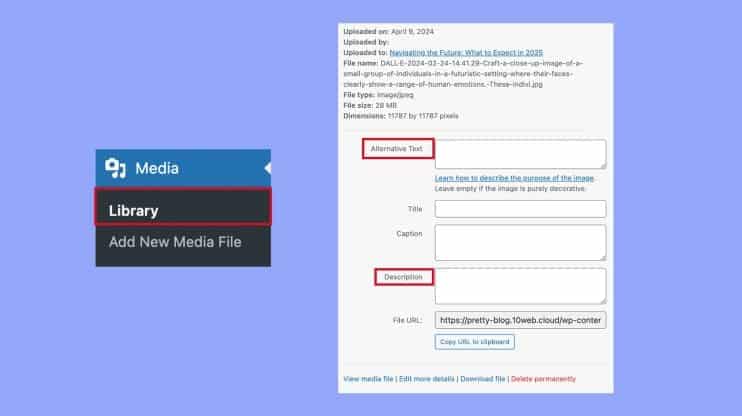
Always add descriptive alt text to your images within the WordPress media library to improve accessibility and on-page signals.
- Compress Images: Utilize a plugin to automatically compress images upon upload, maintaining a noticeable loss in quality. This can drastically reduce file size and improve load times.
- Plugin Recommendations: EWWW Image Optimizer or Smush are excellent choices that automate this process.
- Serve Next-Gen Formats (WebP): Modern image formats, such as WebP, offer superior compression and quality compared to traditional JPEGs and PNGs. Many modern caching and image optimization plugins can automatically convert your images to the WebP format for browsers that support it, further enhancing performance.
Achieving Blazing-Fast Page Speed (Core Web Vitals)
Objective: To improve user experience and satisfy Google’s Core Web Vitals, which are confirmed ranking factors. A slow website directly impacts bounce rates and conversions.
Core Optimization Levers:
- Caching: This is the single most effective speed enhancement for a WordPress site. Caching creates static HTML versions of your pages, so they don’t have to be dynamically generated by PHP for every visitor. This dramatically reduces server load and Time to First Byte (TTFB).
- Plugin Recommendations: WP Rocket is a premium plugin widely regarded as the best all-in-one solution, thanks to its ease of use and powerful features. For users on LiteSpeed servers, the free LiteSpeed Cache plugin is an excellent, highly integrated option.
- Lightweight Theme: A bloated theme with excessive code and scripts is a primary cause of slow sites. Choosing a performance-focused theme is critical.
- Recommendations: Themes like Astra, GeneratePress, and Kadence are consistently ranked among the fastest due to their clean code and minimal bloat.
- Quality Hosting: A slow server will undermine all other optimizations. While a deep dive is beyond the scope of this guide, choosing a reputable managed WordPress host is a foundational requirement for good performance.
Measuring the Impact:
The benefits of page speed optimization are tangible and measurable. A typical site can see dramatic improvements across key metrics after implementing proper caching and optimization techniques.
| Performance Metric | Before Optimization | After Optimization | Improvement |
|---|---|---|---|
| LCP (Largest Contentful Paint) | 3.8s | 1.5s | -60% |
| Total Page Size | 2.1 MB | 750 KB | -64% |
| HTTP Requests | 85 | 30 | -65% |
Data based on typical results from implementing a premium caching plugin like WP Rocket. Source: WP Rocket Case Study.
Your Action Plan: The WordPress On-Page SEO Audit & Final Checklist
Knowledge without action is useless. This final section provides a structured process for auditing your site and a concise checklist to ensure you implement the most critical tasks. A regular SEO audit is the key to maintaining and improving your rankings over time, as it helps identify issues that could be hurting your performance.
The Ultimate WordPress On-Page SEO Checklist (TL;DR)
- Foundational Setup: Set WordPress permalinks to
/%postname%/. - Install & Configure SEO Plugin: Install Rank Math or AIOSEO to manage meta tags and schema.
- Implement Caching: Install and configure WP Rocket to dramatically improve page speed.
- Optimize All Images: Use a plugin like EWWW Image Optimizer to compress images and ensure all have descriptive alt text.
- Deploy Schema Markup: Use your SEO plugin to add
ArticleandFAQPageschema to all relevant content. - Conduct Your First Audit: Perform a comprehensive seo audit using the checklist in Appendix A and technical seo tools like Google Search Console and Screaming Frog.
WordPress On-Page SEO FAQ
Q: How do I add keywords to a WordPress page for on-page SEO?
A: Strategically place your primary keyword in the SEO title, meta description, H1 tag, URL, and the first 100 words of your content. Utilize secondary and related keywords in H2/H3 subheadings, as well as image alt text. Plugins like AIOSEO or Rank Math offer a “Focus Keyphrase” feature to guide you through this process, ensuring natural integration without keyword stuffing.
Q: What is the best permalink structure for WordPress on-page SEO?
A: The best and most recommended permalink structure is “Post name” yourdomain.com/%postname%/). It is clean, user-friendly, and allows you to include your target keyword directly in the URL, which is a positive on-page SEO signal. You can set this in your WordPress dashboard under Settings > Permalinks.
Q: How do I check my WordPress on-page SEO score?
A: Most modern SEO plugins, like AIOSEO (with its TruSEO score) and Rank Math, provide a real-time on-page analysis score directly in the WordPress editor. For a more comprehensive view, use technical SEO tools like Semrush’s On-Page SEO Checker or Ahrefs’ Site Audit to run a full SEO audit of your page against top competitors and receive actionable recommendations.
Final Thoughts
Dominating Google in 2025 requires a disciplined and holistic approach to WordPress on-page SEO. It’s an ongoing process of technical refinement, strategic content creation, and continuous measurement. It’s not about chasing hacks, but about moving faster, making more intelligent decisions, and focusing on what drives real results. By following the framework in this guide, you are not just “doing SEO”; you are building a resilient, authoritative digital asset poised for long-term search visibility. The ability to decipher data and translate that information into an actionable strategy is what differentiates good campaigns from great, lead-generating campaigns.
Appendices
Appendix A: The Complete WordPress Technical SEO Audit Checklist
Use this checklist to perform a regular seo audit on your WordPress site. This process helps identify technical issues that could be hindering your performance.
| Category | Check Item | Status (Pass/Fail) | Tools & Notes |
|---|---|---|---|
| Indexing & Crawlability | Site is visible to search engines (Settings > Reading). | [ ] | Check in WordPress admin. A common but critical error . |
| XML Sitemap is generated and submitted to Google Search Console. | [ ] | Use AIOSEO/Rank Math to generate; submit in GSC. | |
| No critical crawl errors in Google Search Console. | [ ] | Check GSC “Pages” report for 404s and other errors. | |
| Technical Elements | Permalinks are set to /%postname%/. |
[ ] | Check in WordPress admin under Settings > Permalinks. |
| Site uses HTTPS. | [ ] | Check browser for padlock icon. SSL is a confirmed ranking signal . | |
| Only one version of the site is live (WWW vs. non-WWW). | [ ] | Type all 4 versions (http, https, www, non-www) into browser to check for redirects . | |
| On-Page Elements | Every important page has a unique, optimized Title Tag (<60 chars). | [ ] | Use technical seo tools like Screaming Frog to crawl and identify duplicates/long titles. |
| Every important page has a unique, compelling Meta Description (<160 chars). | [ ] | Use Screaming Frog to find missing or duplicate descriptions. | |
| Every page has one, and only one, H1 tag. | [ ] | Use Screaming Frog or browser “Inspect” tool to verify. | |
| No broken internal or external links. | [ ] | Use Ahrefs’; Site Audit or Screaming Frog. Broken links harm user experience and crawlability . | |
| Performance | LCP (Largest Contentful Paint) is below 2.5s. | [ ] | Test with Google PageSpeed Insights. LCP is a key Core Web Vital . |
| Site is mobile-friendly. | [ ] | Test with Google’s Mobile-Friendly Test. Mobile-first indexing is standard . | |
| Schema | Key pages have correct Schema Markup deployed (Article, Product, etc.). | [ ] | Validate with the Rich Results Test. |
Appendix B: Complete Article & FAQ Schema Markup (JSON-LD)
Below is an example of the JSON-LD schema markup for this article. You can adapt this code for your own content by changing the values. This should be placed in the <head> section of your page’s HTML, which can often be done via your SEO plugin’s settings or a code snippets plugin.
<script type="application/ld+json">
{
"@context": "https://schema.org",
"@type": "Article",
"headline": "The Ultimate Guide to WordPress On-Page SEO: Dominate Google Rankings in 2025",
"datePublished": "2025-07-21T09:00:00-05:00",
"dateModified": "2025-07-21T09:00:00-05:00",
"author": {
"@type": "Organization",
"name": "Academic SEO Experts"
},
"publisher": {
"@type": "Organization",
"name": "Academic SEO Experts",
"logo": {
"@type": "ImageObject",
"url": "https://example.com/logo.png"
}
},
"description": "Master WordPress on-page SEO with this step-by-step guide. Covers technical elements, content strategy, and specific WP techniques to dominate rankings in 2025.",
"mainEntityOfPage": {
"@type": "WebPage",
"@id": "https://example.com/wordpress-on-page-seo"
},
"image": {
"@type": "ImageObject",
"url": "https://example.com/featured-image.jpg"
},
"mainEntity": [{
"@type": "Question",
"name": "How do I add keywords to a WordPress page for on-page SEO?",
"acceptedAnswer": {
"@type": "Answer",
"text": "Strategically place your primary keyword in the SEO title, meta description, H1 tag, URL, and the first 100 words of your content. Use secondary and related keywords in H2/H3 subheadings and image alt text. Plugins like AIOSEO or Rank Math provide a 'Focus Keyphrase' feature to guide you."
}
},{
"@type": "Question",
"name": "What is the best permalink structure for WordPress on-page SEO?",
"acceptedAnswer": {
"@type": "Answer",
"text": "The best and most recommended permalink structure is 'Post name' (yourdomain.com/%postname%/). It is clean, user-friendly, and allows you to include your target keyword directly in the URL, which is a positive on-page SEO signal. You can set this in your WordPress dashboard under Settings > Permalinks."
}
},{
"@type": "Question",
"name": "How do I check my WordPress on-page SEO score?",
"acceptedAnswer": {
"@type": "Answer",
"text": "Most modern SEO plugins, like AIOSEO (with its TruSEO score) and Rank Math, provide a real-time on-page analysis score directly in the WordPress editor. For a more comprehensive view, use technical seo tools like Semrush's On-Page SEO Checker or Ahrefs' Site Audit to run a full seo audit of your page against top competitors."
}
}]
}
</script>

With over 27 years of hands-on SEO expertise, starting from my early days as a CFO. Quitting that job to build a top-ranked web hosting business in 1995, I’ve mastered WordPress optimization as a precise engineering discipline. Through extensive research, high-level consulting, and developing a WordPress site that achieved over a thousand organic Google rankings—culminating in a six-figure sale—I’ve decoded Google’s algorithm over 27 years to develop wordpress engineering that transforms underperforming WordPress sites into authoritative powerhouses. Business owners frustrated by stagnant traffic, low visibility, and missed opportunities find relief as I help them deliver measurable ROI through higher rankings, increased leads, and sustainable growth. As owner of dominant city-based SEO platforms in major U.S. markets, I outperform industry gurus, empowering entrepreneurs, local businesses, agencies, and marketers via my WordPress Optimization services at wordpressoptimization.com to unlock their site’s full potential.
